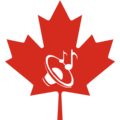| Showcase | Contents | Contributing |
Introduction
Canada is a country in North America. Its ten provinces and three territories extend from the Atlantic Ocean to the Pacific Ocean and northward into the Arctic Ocean, making it the second-largest country by total area, with the longest coastline of any country. Its border with the United States is the longest international land border. The country is characterized by a wide range of both meteorologic and geological regions. With a population of over 41 million, it has widely varying population densities, with the majority residing in its urban areas and large areas being sparsely populated. Canada's capital is Ottawa and its three largest metropolitan areas are Toronto, Montreal, and Vancouver.
A developed country, Canada has a high nominal per capita income globally and its advanced economy ranks among the largest in the world by nominal GDP, relying chiefly upon its abundant natural resources and well-developed international trade networks. Recognized as a middle power, Canada's support for multilateralism and internationalism has been closely related to its foreign relations policies of peacekeeping and aid for developing countries. Canada promotes its domestically shared values through participation in multiple international organizations and forums. (Full article...)
Featured article -
Queen Anne's War (1702–1713) or the Third Indian War was one in a series of French and Indian Wars fought in North America involving the colonial empires of Great Britain, France, and Spain; it took place during the reign of Anne, Queen of Great Britain. In the United States, it is often studied as a standalone conflict under this name, although it is also viewed as the American theater of the War of the Spanish Succession. In France, it was known as the Second Intercolonial War. (Full article...)
Current events
- August 19, 2025 – 2025 Air Canada flight attendants strike
- Air Canada announces it will gradually restart operations tonight after it reached a tentative agreement with the Canadian Union of Public Employees, which represents the airline's over 10,000 flight attendants. (NPR)
- August 18, 2025 – By-elections to the 45th Canadian Parliament
- Conservative Party of Canada leader Pierre Poilievre is elected in a by-election in Battle River—Crowfoot, and returns to the House of Commons and his role as opposition leader after previously losing re-election during the 2025 Canadian federal election in Carleton. The seat was vacated by Conservative MP Damien Kurek to specifically give Poilievre an opportunity to return to Parliament. (The Globe and Mail)
- August 17, 2025 – 2025 Air Canada flight attendants strike
- Air Canada suspends its plan to resume flights after cabin crew continued a strike despite a Canada Industrial Relations Board order and government-imposed arbitration, leaving operations halted and affecting more than 700 flights and about 130,000 daily passengers. (Philippine Daily Inquirer)
- August 16, 2025 – 2025 Air Canada flight attendants strike
- Canadian jobs minister Patty Hajdu orders binding arbitration between Air Canada and the Canadian Union of Public Employees. (BBC News)
- August 6, 2025 –
- A month-long legionnaires' disease outbreak that started on July 8 in London, Ontario, Canada, ends after 70 cases and three deaths. (CFPL-DT)
- August 1, 2025 – Tariffs in the second Trump administration
- U.S. tariffs on more than 90 countries enter force following a 90-day pause to allow the countries to prepare, including a 35% tariff on some Canadian goods and a 50% tariff on Brazilian goods. (BBC News)
Selected panorama -
National symbol -

The National flag of Canada, popularly referred to as the Maple Leaf, consists of a red field with a white square at its centre in the ratio of 1∶2∶1, in which is featured one stylized, red, 11-pointed maple leaf charged in the centre. It is the first flag to have been adopted by both houses of Parliament and officially proclaimed by the Canadian monarch as the country's official national flag. The flag has become the predominant and most recognizable national symbol of Canada. (Full article...)
Selected vital article -
The culture of Canada embodies the artistic, culinary, literary, humour, musical, political and social elements that are representative of Canadians. Throughout Canada's history, its culture has been influenced firstly by its indigenous cultures, and later by European culture and traditions, mostly by the British and French. Over time, elements of the cultures of Canada's immigrant populations have become incorporated to form a Canadian cultural mosaic. Certain segments of Canada's population have, to varying extents, also been influenced by American culture due to shared language (in English-speaking Canada), significant media penetration, and geographic proximity. (Full article...)
Selected picture -
Featured biography -
Elizabeth II (Elizabeth Alexandra Mary; 21 April 1926 – 8 September 2022) was Queen of the United Kingdom and other Commonwealth realms from 6 February 1952 until her death in 2022. She had been queen regnant of 32 sovereign states during her lifetime and was the monarch of 15 realms at her death. Her reign of 70 years and 214 days is the longest of any British monarch, the second-longest of any sovereign state, and the longest of any queen regnant in history. (Full article...)
Did you know -

- ... that the former Essex County Courthouse was designed by an American and built by Canada's future prime minister?
- ... that the roadless Solace Provincial Park in the Temagami area of Ontario, Canada, is considered as one of the most isolated, wild places in the province?
- ... that the first Miss Indigenous Canada contestants were judged on ambassadorship, character, community service, and cultural involvement?
- ... that in 1819 Michael O'Sullivan, a member of the Legislative Assembly of Lower Canada, fought a duel in Montreal with William Caldwell over a proposal to create the Montreal General Hospital?
- ... that the Canada Centre Building has one of the first aquifer thermal energy storage systems?
- ... that Canadian football player Pieter Vanden Bos was traded from the Roughriders to the Rough Riders?
- ... that Leon Hatziioannou played for two different Canadian football teams within 48 hours?
Featured list -
The 400-series highways are a network of controlled-access highways in the Canadian province of Ontario, forming a special subset of the provincial highway system. They are analogous to the Interstate Highway System in the United States or the Autoroute system of neighbouring Quebec, and are regulated by the Ministry of Transportation of Ontario (MTO). The 400-series designations were introduced in 1952, although Ontario had been constructing divided highways for two decades prior. Initially, only Highways 400, 401 and 402 were numbered; other designations followed in the subsequent decades. To this day, not all controlled-access highways in Ontario are a part of the 400-series highway network. The network is situated almost entirely in Southern Ontario, although Highway 400 extends into the more remote northern portion of the province. (Full article...)
Canadian content search
Associated Wikimedia
The following Wikimedia Foundation sister projects provide more on this subject:
-
Commons
Free media repository -
Wikibooks
Free textbooks and manuals -
Wikidata
Free knowledge base -
Wikinews
Free-content news -
Wikiquote
Collection of quotations -
Wikisource
Free-content library -
Wikiversity
Free learning tools -
Wikivoyage
Free travel guide -
Wiktionary
Dictionary and thesaurus




























